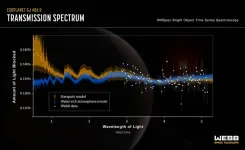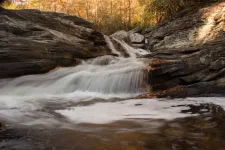(Press-News.org) The most common stars in the universe are red dwarf stars, which means that rocky exoplanets are most likely to be found orbiting such a star. Red dwarf stars are cool, so a planet has to hug it in a tight orbit to stay warm enough to potentially host liquid water (meaning it lies in the habitable zone). Such stars are also active, particularly when they are young, releasing ultraviolet and X-ray radiation that could destroy planetary atmospheres. As a result, one important open question in astronomy is whether a rocky planet could maintain, or reestablish, an atmosphere in such a harsh environment.
To help answer that question, astronomers used NASA’s James Webb Space Telescope to study a rocky exoplanet known as GJ 486 b. It is too close to its star to be within the habitable zone, with a surface temperature of about 800 degrees Fahrenheit (430 degrees Celsius). And yet, their observations using Webb’s Near-Infrared Spectrograph (NIRSpec) show hints of water vapor. If the water vapor is associated with the planet, that would indicate that it has an atmosphere despite its scorching temperature and close proximity to its star. Water vapor has been seen on gaseous exoplanets before, but to date no atmosphere has been definitely detected around a rocky exoplanet. However, the team cautions that the water vapor could be on the star itself – specifically, in cool starspots – and not from the planet at all.
“We see a signal, and it’s almost certainly due to water. But we can't tell yet if that water is part of the planet's atmosphere, meaning the planet has an atmosphere, or if we’re just seeing a water signature coming from the star,” said Sarah Moran of the University of Arizona in Tucson, lead author of the study.
“Water vapor in an atmosphere on a hot rocky planet would represent a major breakthrough for exoplanet science. But we must be careful and make sure that the star is not the culprit,” added Kevin Stevenson of the Johns Hopkins University Applied Physics Laboratory in Laurel, Maryland, principal investigator on the program.
GJ 486 b is about 30% larger than Earth and three times as massive, which means it is a rocky world with stronger gravity than Earth. It orbits a red dwarf star in just under 1.5 Earth days. It is expected to be tidally locked, with a permanent day side and a permanent night side.
GJ 486 b transits its star, crossing in front of the star from our point of view. If it has an atmosphere, then when it transits starlight would filter through those gasses, imprinting fingerprints in the light that allow astronomers to decode its composition through a technique called transmission spectroscopy.
The team observed two transits, each lasting about an hour. They then used three different methods to analyze the resulting data. The results from all three are consistent in that they show a mostly flat spectrum with an intriguing rise at the shortest infrared wavelengths. The team ran computer models considering a number of different molecules, and concluded that the most likely source of the signal was water vapor.
While the water vapor could potentially indicate the presence of an atmosphere on GJ 486 b, an equally plausible explanation is water vapor from the star. Surprisingly, even in our own Sun, water vapor can sometimes exist in sunspots because these spots are very cool compared to the surrounding surface of the star. GJ 486 b’s host star is much cooler than the Sun, so even more water vapor would concentrate within its starspots. As a result, it could create a signal that mimics a planetary atmosphere.
“We didn't observe evidence of the planet crossing any starspots during the transits. But that doesn't mean that there aren't spots elsewhere on the star. And that's exactly the physical scenario that would imprint this water signal into the data and could wind up looking like a planetary atmosphere,” explained Ryan MacDonald of the University of Michigan in Ann Arbor, one of the study’s co-authors.
A water vapor atmosphere would be expected to gradually erode due to stellar heating and irradiation. As a result, if an atmosphere is present, it would likely have to be constantly replenished by volcanoes ejecting steam from the planet’s interior. If the water is indeed in the planet’s atmosphere, additional observations are needed to narrow down how much water is present.
Future Webb observations may shed more light on this system. An upcoming Webb program will use the Mid-Infrared Instrument (MIRI) to observe the planet’s day side. If the planet has no atmosphere, or only a thin atmosphere, then the hottest part of the day side is expected to be directly under the star. However, if the hottest point is shifted, that would indicate an atmosphere that can circulate heat.
Ultimately, observations at shorter infrared wavelengths by another Webb instrument, the Near-Infrared Imager and Slitless Spectrograph (NIRISS), will be needed to differentiate between the planetary atmosphere and starspot scenarios.
“It’s joining multiple instruments together that will really pin down whether or not this planet has an atmosphere,” said Stevenson.
The study is accepted for publication in The Astrophysical Journal Letters.
The James Webb Space Telescope is the world’s premier space science observatory. Webb will solve mysteries in our solar system, look beyond to distant worlds around other stars, and probe the mysterious structures and origins of our universe and our place in it. Webb is an international program led by NASA with its partners, ESA (European Space Agency) and the Canadian Space Agency.
END
Webb finds water vapor, but from a rocky planet or its star?
2023-05-01
ELSE PRESS RELEASES FROM THIS DATE:
Cannabis knocks down pain, improves sleep and lifts brain fog in cancer patients
2023-05-01
Cancer patients who use cannabis to address their symptoms have less pain and sleep better, according to new University of Colorado Boulder research. But they also experience another, unexpected, benefit: After a few weeks of sustained use, they seem to think more clearly.
“When you’re in a lot of pain, it’s hard to think,” said senior author Angela Bryan, a professor of psychology and neuroscience at CU Boulder and a cancer survivor. “We found that when patients’ pain levels came down after using cannabis for a while, their cognition got better.”
The small but groundbreaking study, published ...
Jutras Lab awarded $1.2 million to create rapid and accurate Lyme disease testing
2023-05-01
A rapid, at-home test that can diagnose acute Lyme disease? That is the goal for researcher Brandon Jutras and his team at Virginia Tech’s Fralin Life Sciences Institute.
Through the support of a recent $1.2 million multiyear therapeutic/diagnostic research tick-borne disease grant awarded by the Department of Defense, Jutras' vision may one day become a reality. This research award aims to improve patient care and quality of life for military service members, veterans, and their beneficiaries as well as the American public living with Lyme disease and other tick-borne diseases.
“Current ...
Study: Police murder of George Floyd associated with short-term spike in firearm assaults on US police officers
2023-05-01
The police murder of George Floyd sparked nationwide protests in the summer of 2020 and revived claims that public outcry over such high-profile police killings perpetuates a violent “war on cops.” In a new study, researchers assessed if and how patterns of firearm assault on police officers in the United States were influenced by the police murder of Floyd. The study found that Floyd’s murder was associated with a three-week spike in firearm assaults on police, after which the trend in such assaults dropped to levels slightly above those predicted by pre-Floyd ...
West Antarctic Ice Sheet retreated far inland, re-advanced since last Ice Age
2023-05-01
WASHINGTON — The West Antarctic Ice Sheet is melting rapidly, raising concerns it could cross a tipping point of irreversible retreat in the next few decades if global temperatures rise 1.5 to 2.0 degrees Celsius (2.7 to 3.8 degrees Fahrenheit) above preindustrial levels. New research finds that 6,000 years ago, the grounded edge of the ice sheet may have been as far as 250 kilometers (160 miles) inland from its current location, suggesting the ice retreated deep into the continent after the end of the last ice age and re-advanced before modern retreat began.
“In the last few thousand years before we started watching, ...
Young women more likely to return to the hospital in year following heart attack
2023-05-01
Young women who experience a heart attack have more adverse outcomes and are more likely to end up back in the hospital compared to men of a similar age in the year following discharge. According to a study published in the Journal of the American College of Cardiology, second heart attack and chest pain due to the heart are the most common causes of rehospitalization, but non-cardiac hospitalizations showed the most significant disparity.
“This all begins with public awareness towards preventing heart attacks and screening ...
Risk of rehospitalization in younger women after heart attack nearly double that of men
2023-05-01
Women aged 55 years and younger have nearly double the risk of rehospitalization in the year immediately after a heart attack compared to men of similar age, according to a study supported by the National Institutes of Health. Higher rates of risk factors such as obesity, heart failure, and depression among women most likely contributed to the disparity.
The findings suggest a need for closer health monitoring of the approximately 40,000 American women aged 18 to 55 years who have heart attacks each year following hospital discharge, and a better understanding of the reasons behind ...
Nuances of the forest-water connection
2023-05-01
The infrastructure that brings drinking water to homes is an investment. For millions of people, forests are part of the system behind their faucets. Over the coming decades, many forested watersheds could be lost to development, lowering water quality and raising water treatment costs, according to a new study published in the journal Science of the Total Environment.
The research team focused on the forest-water connection in the southern U.S., a complex, heterogeneous region and, unfortunately, an ideal place for studying forest loss and worsening water quality. ...
Study identifies genetic mutations that contribute to adult epilepsy
2023-05-01
Epilepsy affects approximately 1-in-26 people and the most common form, known as temporal lobe epilepsy (TLE), often cannot be adequately treated with anti-seizure medications. Patients with this form of epilepsy may require neurosurgery to provide relief from seizures. The condition’s origins and progression are not well understood, and it has been unclear if genetic mutations may contribute to TLE. A new study by investigators from Mass General Brigham, in collaboration with colleagues at Boston Children’s Hospital, sheds new light on the role of somatic mutations in TLE — DNA alterations that occur after conception — and suggests the potential ...
Massive radio array to search for extraterrestrial signals from other civilizations
2023-05-01
May 1, 2023, Mountain View, CA – One of the world’s most powerful radio telescope arrays is joining the hunt for signals from other galactic civilizations. The National Science Foundation’s Karl G. Jansky Very Large Array (VLA), situated about 50 miles west of Socorro, New Mexico, is collecting data that scientists will analyze for the type of emissions that only artificial transmitters make, signals that would betray the existence of a technically accomplished society.
“The VLA is the ...
Lower-income, working cancer caregivers experience harder financial impacts
2023-05-01
Cancer is a disease of ripples – from symptoms that precede a diagnosis to treatment, side effects, and goals for long-term survival. It can impact every facet of life, for the person who receives the diagnosis as well as the person who is their caregiver.
For caregivers, the economic impacts of cancer can be particularly acute, not just because cancer is an expensive disease, but because their ability to work may be significantly impacted.
Building on an extensive foundation of previous research studying employment and outcomes related to cancer, newly published ...






